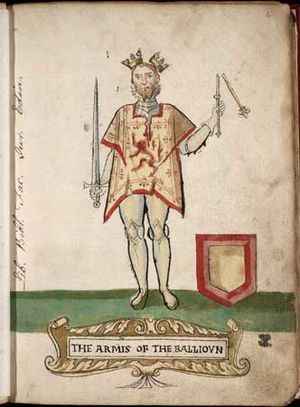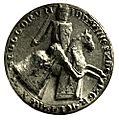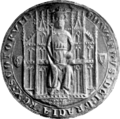John Balliol facts for kids
Quick facts for kids John |
|
|---|---|

King John, with his crown and sceptre symbolically broken and with an empty coat of arms as depicted in the 1562 Forman Armorial, produced for Mary, Queen of Scots
|
|
| King of Scots | |
| Reign | 17 November 1292 – 10 July 1296 |
| Coronation | 30 November 1292 |
| Predecessor | Margaret (1290) |
| Successor | Robert I (1306) |
| Born | c. 1249 |
| Died | late 1314 (aged around 65) Château de Hélicourt, Picardy, France |
| Burial | prob. Hélicourt |
| Spouse | Isabella de Warenne |
| Issue | Edward Balliol |
| House | House of Balliol |
| Father | John I de Balliol |
| Mother | Dervorguilla of Galloway |
John Balliol (born around 1249 – died late 1314) was the King of Scots from 1292 to 1296. People sometimes called him Toom Tabard, which means "empty coat". This nickname suggested he was not a strong king.
Not much is known about John Balliol's early life. After Margaret, Maid of Norway, who was supposed to be the next queen, died, Scotland needed a new ruler. Many powerful people wanted to be king. John Balliol was chosen by a group of Scottish nobles, with help from King Edward I of England.
King Edward I used his power to try and control Scotland. He treated Scotland like it was a smaller country that had to obey England. This made John Balliol's time as king very difficult. The Scottish nobles eventually removed him from power. They created a special council to rule instead. This council then made an important agreement with France called the Auld Alliance.
Because of this alliance, Edward I invaded Scotland. This started the Wars of Scottish Independence. After a big defeat in 1296, John Balliol gave up his crown. He was sent to prison in the Tower of London. Later, he went to live on his family's lands in France and stayed out of politics. Scotland did not have a king again until Robert the Bruce became king in 1306. John Balliol's son, Edward Balliol, later tried to become king of Scotland too.
Contents
What Was John Balliol's Nickname?
John Balliol was known as Toom Tabard in Scots. This nickname means "empty coat". It was given to him because people thought he was not a very effective king. It might also refer to his coat of arms being taken from him in public.
Where Did John Balliol Come From?
Not much is known about when or where John Balliol was born. He was likely born between 1248 and 1250. His father was John I de Balliol, who was a powerful lord and started Balliol College at Oxford University. His mother was Dervorguilla of Galloway.
Through his mother, John inherited a lot of land in Scotland, especially in a place called Galloway. He also inherited land in England. From his father, he received large estates in England and France.
How Did John Balliol Become King of Scotland?
In 1284, John Balliol was part of a Scottish meeting that agreed Margaret, Maid of Norway would be the next ruler. But Margaret died in 1290. This left Scotland without a clear leader. Many powerful families, including John Balliol, claimed they should be the next king. This event was called the Great Cause.
John Balliol had a strong claim because he was a great-great-great-grandson of an earlier Scottish king, David I. King Edward I of England was asked to help decide who should be king. On November 17, 1292, the decision was made in favor of John Balliol. He was crowned King of Scotland on November 30, 1292, at Scone.
Edward I, however, used his power to control Scotland. He made John Balliol promise to be loyal to him. Edward also demanded that Scotland help England in its wars and pay money. He treated Scotland as if it were a smaller part of his own kingdom. The Scottish nobles became very unhappy with this. In 1295, they took control from John Balliol. They formed a council of twelve leaders to rule Scotland. This council then made a secret agreement with France to help each other against England. This agreement became known as the Auld Alliance.
Why Did John Balliol Give Up His Crown?
King Edward I was very angry about Scotland's alliance with France. He invaded Scotland, starting the Wars of Scottish Independence. The Scottish army was defeated at the Battle of Dunbar in April 1296.
On July 10, 1296, John Balliol officially gave up his crown near Montrose. It was here that the symbols of Scotland were taken from his royal coat, which is why he got the nickname "Toom Tabard" (empty coat).
John was then sent to prison in the Tower of London. In 1299, he was allowed to go to France. When his belongings were checked, the Scottish crown and royal seal were found. Edward I kept the seal but sent the crown to a church in England. John lived the rest of his life quietly on his family's lands in France.
Even after John left Scotland, some Scottish rebels, like William Wallace, claimed they were fighting in King John Balliol's name. But John could not return to Scotland or help them. Scotland was left without a king until Robert the Bruce became king in 1306.
When Did John Balliol Die?
John Balliol died in late 1314 at his family's castle in France. His son, Edward Balliol, later tried to become King of Scotland, with support from England. He had some success for a short time.
Who Was John Balliol's Family?
John Balliol married Isabella de Warenne around 1281. Her mother was related to an English king, Henry III of England. John was also the uncle of John Comyn III of Badenoch, a powerful Scottish noble who was later killed by Robert the Bruce.
John and Isabella had at least one child:
- Edward Balliol (died 1364). He later claimed the Scottish throne.
Some historians believe they might have had other children too, including a son named Henry and daughters named Agnes and Margaret.
How Has John Balliol Been Portrayed in Stories?
John Balliol has appeared in plays and movies:
- A play called John Balliol, An Historical Drama was written about his life in 1825.
- In the 1995 movie Braveheart, an actor plays a character named Balliol. This character is shown as someone who wanted to be king of Scotland. However, the movie is mostly fictional, and the real John Balliol was in prison in France at that time.
See also
 In Spanish: Juan de Balliol para niños
In Spanish: Juan de Balliol para niños
Images for kids





